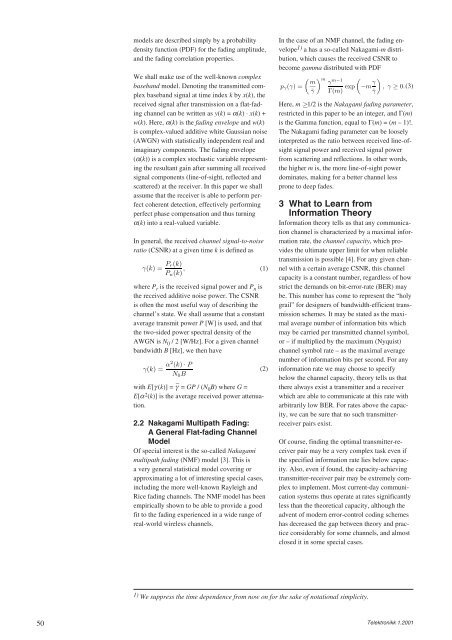Create successful ePaper yourself
Turn your PDF publications into a flip-book with our unique Google optimized e-Paper software.
50<br />
models are described simply by a probability<br />
density function (PDF) for the fading amplitude,<br />
and the fading correlation properties.<br />
We shall make use of the well-known complex<br />
baseband model. Denoting the transmitted complex<br />
baseband signal at time index k by x(k), the<br />
received signal after transmission on a flat-fading<br />
channel can be written as y(k) = α(k) ⋅ x(k) +<br />
w(k). Here, α(k) is the fading envelope and w(k)<br />
is complex-valued additive white Gaussian noise<br />
(AWGN) with statistically independent real and<br />
imaginary components. The fading envelope<br />
(α(k)) is a complex stochastic variable representing<br />
the resultant gain after summing all received<br />
signal components (line-of-sight, reflected and<br />
scattered) at the receiver. In this paper we shall<br />
assume that the receiver is able to perform perfect<br />
coherent detection, effectively performing<br />
perfect phase compensation and thus turning<br />
α(k) into a real-valued variable.<br />
In general, the received channel signal-to-noise<br />
ratio (CSNR) at a given time k is defined as<br />
(1)<br />
where Pr is the received signal power and Pn is<br />
the received additive noise power. The CSNR<br />
is often the most useful way of describing the<br />
channel’s state. We shall assume that a constant<br />
average transmit power P [W] is used, and that<br />
the two-sided power spectral density of the<br />
AWGN is N0 / 2 [W/Hz]. For a given channel<br />
bandwidth B [Hz], we then have<br />
(2)<br />
with E[γ (k)] = γ – = GP / (N0B) where G =<br />
E[α 2 γ(k) =<br />
(k)] is the average received power attenuation.<br />
Pr(k)<br />
Pn(k) ,<br />
γ(k) = α2 (k) · P<br />
N0B<br />
2.2 Nakagami Multipath Fading:<br />
A General Flat-fading Channel<br />
Model<br />
Of special interest is the so-called Nakagami<br />
multipath fading (NMF) model [3]. This is<br />
a very general statistical model covering or<br />
approximating a lot of interesting special cases,<br />
including the more well-known Rayleigh and<br />
Rice fading channels. The NMF model has been<br />
empirically shown to be able to provide a good<br />
fit to the fading experienced in a wide range of<br />
real-world wireless channels.<br />
In the case of an NMF channel, the fading envelope1)<br />
a has a so-called Nakagami-m distribution,<br />
which causes the received CSNR to<br />
become gamma distributed with PDF<br />
� �m m−1<br />
m γ<br />
pγ(γ) =<br />
(3)<br />
¯γ Γ(m)<br />
Here, m 1/2 is the Nakagami fading parameter,<br />
restricted in this paper to be an integer, and Γ(m)<br />
is the Gamma function, equal to Γ(m) = (m – 1)!.<br />
The Nakagami fading parameter can be loosely<br />
interpreted as the ratio between received line-ofsight<br />
signal power and received signal power<br />
from scattering and reflections. In other words,<br />
the higher m is, the more line-of-sight power<br />
dominates, making for a better channel less<br />
prone to deep fades.<br />
exp<br />
�<br />
−m γ<br />
�<br />
, γ ≥ 0.<br />
¯γ<br />
≥<br />
3 What to Learn from<br />
Information Theory<br />
Information theory tells us that any communication<br />
channel is characterized by a maximal information<br />
rate, the channel capacity, which provides<br />
the ultimate upper limit for when reliable<br />
transmission is possible [4]. For any given channel<br />
with a certain average CSNR, this channel<br />
capacity is a constant number, regardless of how<br />
strict the demands on bit-error-rate (BER) may<br />
be. This number has come to represent the “holy<br />
grail” for designers of bandwidth-efficient transmission<br />
schemes. It may be stated as the maximal<br />
average number of information bits which<br />
may be carried per transmitted channel symbol,<br />
or – if multiplied by the maximum (Nyquist)<br />
channel symbol rate – as the maximal average<br />
number of information bits per second. For any<br />
information rate we may choose to specify<br />
below the channel capacity, theory tells us that<br />
there always exist a transmitter and a receiver<br />
which are able to communicate at this rate with<br />
arbitrarily low BER. For rates above the capacity,<br />
we can be sure that no such transmitterreceiver<br />
pairs exist.<br />
Of course, finding the optimal transmitter-receiver<br />
pair may be a very complex task even if<br />
the specified information rate lies below capacity.<br />
Also, even if found, the capacity-achieving<br />
transmitter-receiver pair may be extremely complex<br />
to implement. Most current-day communication<br />
systems thus operate at rates significantly<br />
less than the theoretical capacity, although the<br />
advent of modern error-control coding schemes<br />
has decreased the gap between theory and practice<br />
considerably for some channels, and almost<br />
closed it in some special cases.<br />
1) We suppress the time dependence from now on for the sake of notational simplicity.<br />
Telektronikk 1.2001

















